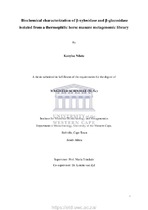| dc.description.abstract | The complete degradation of recalcitrant lignocellulose biomass into value-added products requires the efficient and synergistic action of lignocellulose degrading enzymes. This has resulted in a need for the discovery of new hydrolytic enzymes which are more effective than commonly used ones. β-xylosidases and β-glucosidases are key glycoside hydrolases (GHs) that catalyse the final hydrolytic steps of xylan and cellulose degradation, essential for the complete degradation of lignocellulose. Functional-based metagenomics has been employed successfully for the identification and discovery of novel GH genes from a metagenome library. Therefore, this approach was used in this study to increase the chances of discovering novel glycoside hydrolase genes from a horse manure metagenomic DNA library constructed in a previous study. Three fosmid clones P55E4, P81G1, and P89A4 exhibiting β-xylosidase activity were found to encode putative glycosyl hydrolases designated XylP55, XylP81, and BglP89. Amino acid sequence analysis revealed that XylP55, XylP81, and BglP89 are members of the GH43, GH39, and GH3 glycoside hydrolase families, respectively. Phylogenetic analysis of XylP81 and BglP89 indicated that these showed relatively low sequence similarities to other homologues in the respective GH families. The enzymes were expressed and purified, and only XylP81 and BglP89 were biochemically characterized. XylP81 (~58 kDa) and BglP89 (~84 kDa) both showed optimum activity at pH 6 and 50℃ and retained 100% residual activity at 55℃ after 1-hour indicating that they are moderately thermostable. XylP81 had high specific activity against 4-nitrophenyl-β-D-xylopyranoside (pNPX; 122 U/mg) with a KM value of 5.3 mM, kcat/KM of 20.3 s-1mM-1, and it showed enzyme activity against α-L-arabinofuranosidase, β-galactosidase, and β-glucosidase activity. BglP89 had a high specific activity for 4-nitrophenyl-β-D-glucopyranoside (pNPG; 133.5 U/mg) with a KM value of 8.4 mM, kcat/KM of 22 s-1mM-1 and also showed α-L-arabinofuranosidase, β-galactosidase, β-glucosidase, and low β-xylosidase activity. BglP89 also showed low hydrolytic activity on cellobiose, β-glucan, and lichenan indicating that it is a broad specificity β-glucosidase. XylP81 retained ~40% activity in the presence of 3 M xylose whilst BglP89 showed considerable glucose tolerance at 150 mM glucose and retained ~46% residual activity. This study reveals two metagenomic derived enzymes (β-xylosidase and β-glucosidase) showing characteristics that could make them potential candidates for lignocellulose biomass degradation in biotechnological and industrial applications. | en_US |

